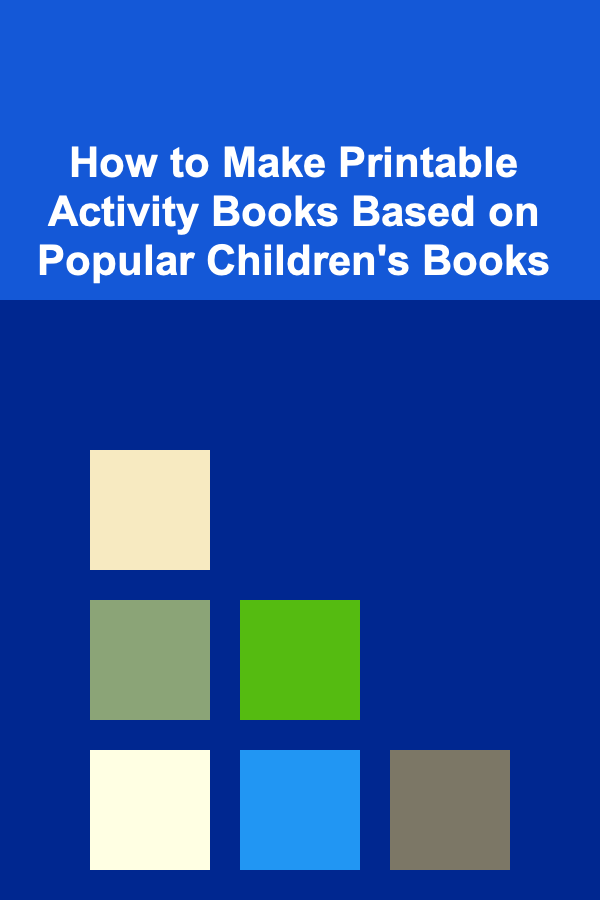
How to Make Printable Activity Books Based on Popular Children's Books
ebook include PDF & Audio bundle (Micro Guide)
$12.99$8.99
Limited Time Offer! Order within the next:

Creating printable activity books based on popular children's books can be a fun and creative project. These activity books provide children with an interactive way to engage with the stories, characters, and themes of beloved books. In this article, we will explore the step-by-step process of creating these activity books, from concept to execution. We will also discuss important considerations for ensuring that the activities are both educational and enjoyable for children. Whether you're a teacher, parent, or aspiring author, this guide will help you craft printable activity books that can foster creativity, learning, and a love for reading.
Understanding the Importance of Activity Books
Activity books are more than just a way to pass the time; they provide children with an opportunity to engage with stories in a deeper way. By creating activity books based on popular children's books, you allow children to dive into the world of their favorite characters and settings, all while encouraging critical thinking, problem-solving, and creative expression.
Educational Value
- Enhancing Comprehension: Activities such as word searches, crosswords, and puzzles can reinforce the themes, plotlines, and characters of the book. They help children better understand the material.
- Promoting Fine Motor Skills: Many activities involve drawing, cutting, coloring, or tracing, which are essential for developing hand-eye coordination and fine motor skills.
- Encouraging Imagination: Crafting activities that allow children to add their own spin to the story or its characters can stimulate imagination and creative thinking.
Emotional Engagement
Children are more likely to retain information and foster a love for reading when they are emotionally connected to the story. An activity book based on a popular children's book can enhance this connection by providing a hands-on experience that allows kids to interact with the story in a meaningful way.
Choose the Right Children's Book
The first step in creating an activity book is to select the right children's book to base the activities on. Not all books will translate well into activity books, so consider the following factors when making your choice:
Age-Appropriate Content
The book you choose should match the age group of the children for whom the activity book is intended. For younger children (ages 4-7), choose picture books with simple narratives and colorful illustrations. For older children (ages 8-12), you might consider chapter books with more complex plots.
Popularity and Relevance
Consider books that are already popular with children or have been on best-seller lists. Familiarity with the book will make the activity book more appealing to children. Books that feature beloved characters, themes, or settings are often great choices.
Educational Themes
Books with educational content, such as teaching about friendship, nature, science, or problem-solving, offer endless possibilities for educational activities. These can be great for reinforcing academic skills while still being fun.
Examples of Popular Books for Activity Books:
- "Where the Wild Things Are" by Maurice Sendak: A classic choice for younger children, this book's imaginative world lends itself to drawing and creative writing activities.
- "Harry Potter and the Sorcerer's Stone" by J.K. Rowling: A fantastic choice for older children, with opportunities to create puzzles, word searches, and character analysis activities.
- "The Very Hungry Caterpillar" by Eric Carle: This beloved picture book offers numerous possibilities for activities related to colors, counting, and the life cycle of a butterfly.
Designing Your Activity Book
Once you've chosen a book, it's time to plan and design your activity book. The goal is to make sure that the activities reflect the themes, characters, and overall spirit of the book while offering a variety of engaging exercises.
Brainstorming Activities
Think about the different elements of the book that could be turned into an activity. Here are some common activities to include in an activity book based on a children's story:
- Word Puzzles: Word searches, crosswords, and jumbles that incorporate key terms from the book. These can be themed around characters, settings, or key events.
- Coloring Pages: Provide outlines of scenes or characters from the book for children to color. Ensure the images are simple and appropriate for the age group.
- Drawing and Writing Prompts: Encourage creativity by asking children to draw their own versions of the book's characters or write alternate endings for the story.
- Matching Games: Create games that ask children to match characters to their actions or plot events to their outcomes.
- Connect-the-Dots: Use illustrations from the book and turn them into connect-the-dot activities to help with counting and fine motor skills.
- Fact Sheets: For books based on nature or historical topics, create fact sheets where children can learn about the real-life inspiration behind the story.
- Word Scrambles and Riddles: Include activities where children have to unscramble words or solve riddles related to the plot or characters.
Organizing the Activities
Make sure your activity book flows well and is easy for children to navigate. Start with simpler activities, such as coloring pages or basic word puzzles, and gradually move on to more challenging tasks. You can group activities by themes or stages of the story to create a logical progression.
Customizing for Different Age Groups
Consider the difficulty level of each activity based on the age group. For younger children, focus on activities that build fine motor skills, such as coloring and tracing. For older children, include more challenging activities like puzzles, quizzes, and comprehension questions that require critical thinking and analysis.
Creating Visuals for the Activity Book
Since the activity book will be printable, you need to create or find visuals that are easy to print and engaging. The visuals should be relevant to the book and enhance the overall experience for the child.
Use Copyright-Compliant Images
It's important to remember that children's books are often copyrighted, and you cannot use the original illustrations from the book unless you have permission from the copyright holder. However, you can create your own illustrations that are inspired by the book's style, or you can use royalty-free images or public domain content.
Design Tools
There are several tools available for creating visuals for your activity book, such as:
- Canva: A user-friendly tool for creating custom illustrations and templates. Canva offers a variety of free design assets that you can use to enhance your activity book.
- Adobe Illustrator: If you're comfortable with graphic design, Illustrator is great for creating high-quality images and custom illustrations.
- Freepik: A website offering a large selection of free and paid illustrations and vectors that you can use in your activity book.
Tips for Creating Visuals:
- Keep illustrations simple and clear. Avoid overly complex images that might confuse young children.
- Use bright, appealing colors that match the tone and theme of the original book.
- Ensure that images are large enough to be printed clearly.
Assembling the Activity Book
Once you have your activities and visuals ready, it's time to assemble the activity book. The layout should be clean, with easy-to-read text and well-organized activities. Here's how to approach the assembly process:
Format and Design
You can use tools like Microsoft Word, Google Docs, or specialized design software like Adobe InDesign to arrange your activities into a printable format. Make sure the pages are clearly numbered, and each activity is neatly separated from the others.
Add Instructions
Each activity should include clear, simple instructions, especially for younger children. You don't want to overwhelm them with too much text, so keep the directions concise and easy to understand.
Test Printing
Before finalizing your activity book, test-print a few pages to ensure the layout looks good on paper. Check for any formatting issues, image clarity, or typos. It's also essential to ensure that the activities are appropriately spaced so they don't become too cramped when printed.
Distribute and Share the Activity Book
Once your activity book is designed and tested, you can make it available for others. There are several ways to distribute your printable activity books:
Online Platforms
- Etsy: You can sell or give away printable activity books on platforms like Etsy. Simply upload your PDF file, and users can purchase or download the book directly.
- Teachers Pay Teachers: This platform is a great place to sell educational materials, including printable activity books.
- Your Own Website: If you have a website or blog, you can offer the activity book as a free download or a paid product.
Sharing with Schools and Libraries
If you're creating activity books as an educational tool, you might want to consider sharing them with local schools, libraries, or homeschool networks. You can either print copies to donate or offer the books as downloadable PDFs for teachers and parents.
Marketing Your Activity Book
If you're selling your activity book, marketing is crucial to ensuring it reaches your target audience. Here are a few strategies:
- Social Media: Use platforms like Instagram, Pinterest, and Facebook to showcase the activity book. Share images of the pages, activities, and positive feedback from users.
- Collaborations: Partner with children's authors, bloggers, or educators who can promote your activity book to their audience.
- Blogging: If you have a blog, write posts related to the children's book you're basing your activity book on. Include tips for parents and teachers on how to use the activity book.
Conclusion
Creating printable activity books based on popular children's books is an exciting and rewarding project. By following these steps and considering important factors such as age appropriateness, creativity, and educational value, you can produce activity books that children will love and parents will appreciate. Whether you're creating the book for personal use or to share with a larger audience, this process allows you to bring stories to life in a fun, interactive way while encouraging children to learn and grow through creative play.
Reading More From Our Other Websites
- [Personal Financial Planning 101] How to Set Financial Goals and Achieve Them Consistently
- [Organization Tip 101] How to Choose the Right Office Supplies for Maximum Efficiency
- [Home Space Saving 101] How to Create a Minimalist Living Room That Saves Space
- [Home Security 101] How to Install and Maintain a Home Security Alarm System
- [Home Rental Property 101] How to Get the Most Out of Your Rental Property Tax Deductions
- [Personal Care Tips 101] How to Use Hair Mousse to Achieve Salon-Quality Volume and Body
- [Personal Finance Management 101] How to Automate Your Savings for a Stress-Free Future
- [Biking 101] The Ultimate Guide to Bike Accessories: Enhance Your Ride with the Right Gear
- [Home Lighting 101] How to Use Smart Lighting to Improve Your Home's Efficiency
- [Personal Care Tips 101] How to Choose a Brow Gel for Thin or Sparse Eyebrows
Becoming a Successful Architect: Essential Skills for Building Iconic Structures
Read More
How to Design a Functional Home Office That Saves Space
Read More
How to Use Hooks and Racks for Entryway Organization
Read More
How to Understand the Truth About Credit Card Debt Consolidation Companies
Read More
How to Transition into Product Management: A Career Guide
Read More
How to Pack a Carry-On for a Week-Long European Adventure
Read MoreOther Products
Becoming a Successful Architect: Essential Skills for Building Iconic Structures
Read More
How to Design a Functional Home Office That Saves Space
Read More
How to Use Hooks and Racks for Entryway Organization
Read More
How to Understand the Truth About Credit Card Debt Consolidation Companies
Read More
How to Transition into Product Management: A Career Guide
Read More